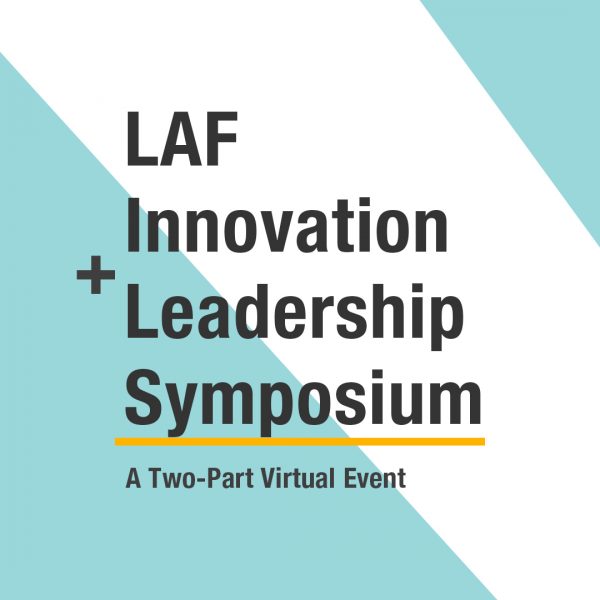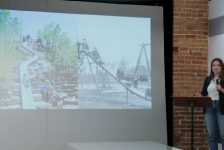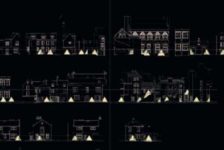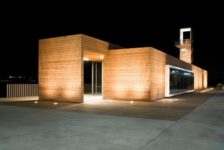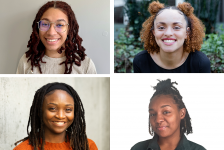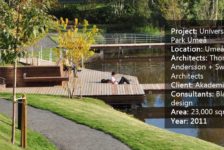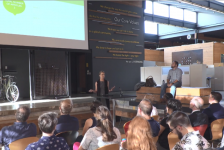This year’s annual LAF Innovation + Leadership Symposium showcased leading-edge thinking in landscape architecture to address a breadth of pressing issues. During this two-part virtual event, the six 2019-2020 LAF Fellowship for Innovation and Leadership recipients presented their projects as the culmination of their year-long fellowship. The symposium is a celebration of the fellows’ journey to develop their leadership capacity and work on ideas that have the potential to create positive and profound change in the profession, the environment, and humanity.
< RELATED: LAF Innovation + Leadership Symposium Goes Virtual: Part 2 >
Established in 2016, the Fellowship for Innovation and Leadership was created to “foster transformational leadership capacity and support innovations to advance the field of landscape architecture”. This $25,000 fellowship is an opportunity for professionals to dedicate the equivalent of 3 months’ time over the course of one year to a proposed project that has the potential to bring positive change and expand the discipline’s impact. The funds provide mid-career and senior-level landscape architects the ability to think deeply, reflect, research, explore, create, test, and develop their ideas into action. In addition to the funds, the LAF Fellows receive project support through facilitated discussions, critiques, mentorship, and explorations of transformational leadership that occur during three 3-day residencies in Washington, DC, as well as monthly conference calls.
Like many recent events, the symposium saw a change of format this year and was hosted virtually. This is just one of the ways in which the coronavirus pandemic is expected to impact the landscape architecture profession. While quarantine has illustrated the importance of public space, it has also reminding us that access and treatment within these spaces in unequal. In a joint statement prepared by the 2019-2020 cohort, the Fellows recognize the systemic racism rooted in landscapes, and the progress to be made toward addressing urban inequity, stating: “Watching these events unfold, it became clear that the discourse in landscape architecture must change; that our work has too often been complicit in the marginalization and oppression of black and brown lives. It is up to us to imagine new futures, to dismantle oppressive power structures, and embrace our differences.”
In this moment of crisis, the urgency of the Fellow’s research topics have become even more apparent. As past LAF President Cindy Sanders stated, “Now, of all times, is not the time to stop programs that supports innovation and leadership development. The events of the last few months have only underscored our collective need for transformational leaders who can take us through these difficulties to a more sustainable, equitable, and just world.” This symposium provides a platform to bring important conversations to broader audiences and bring about much-needed societal change.
This online event was broken into two sessions, each day featuring presentations from three of the Fellows. The first session featured fellows Jeffrey Hou, Professor of Landscape Architecture and Director of Urban Commons Lab at University of Washington, Liz Camuti, Landscape Designer at SCAPE, and Diana Fernandez, Associate at Sasaki.
Jeff Hou – Design as Activism: Educating for Social Change
Facing environmental and social crises on a global scale, how can landscape architecture education prepare students to become changemakers in meeting these challenges? Fellow Jeff Hou sought to answer this question in his presentation Design as Activism: Educating for Social Change, in which he presented a framework of actions to reposition and transform landscape architecture education for social change. Using design as a vehicle for change, the profession of landscape architecture has the capacity to make a more meaningful contribution to society in terms of equity, justice, and resilience. To grow our collective capacity and build future leaders, Hou suggests we need to better integrate design activism into the educational curriculum.
In his research, Hou explored the different expressions of design activism, the skills and knowledge needed for practicing it, and the actions needed to integrate it into curriculum. Working alongside his students at University of Washington and receiving input from a network of university program leaders and practitioners across the county, Hou created a 50-page document titled “Design As Activism: A Framework for Actions in Landscape Architecture Education”. The document outlines a series of principles to guide actions that programs can take to integrate design activism into their curriculum. As Hou states, “Each of these actions represent an opportunity to transform the way we teach and the way we learn, to expand the skills and knowledge of our future professionals, and to recognize the power of design in bringing about change.” Calling on us all to make this transformation happen, Hou plans to distribute the documents to universities around the country and seek endorsements from leaders.
Liz Camuti – Un-Checking the Boxes: Learning to Read Between the Lines of Climate Resilience RFPs
Although socially and economically marginalized communities are the first to be affected by climate change, their voices are often some of the first to be ignored. Fellow Liz Camuti invites us to think differently about resiliency planning and our capacity as landscape architects to give voice to vulnerable communities. Using the resettlement of Isle de Jean Charles – a sliver of island 80 miles southwest of New Orleans – as a case study, Camuti’s work, titled Un-Checking the Boxes: Learning to Read Between the Lines of Climate Resilience RFPs, questions: 1) how criteria for a “successful” project might evolve through a different form of RFP, and 2) how designers can adapt their roles to break cycles of erasure and control that have shaped environmental history in Louisiana.
The residents of the Isle de Jean Charles are Louisiana’s first climate refugees. The historic homeland to the Biloxi-Chitimacha-Choctaw tribe, this primarily American Indian community has lost 98% of its land due to rising sea levels, saltwater intrusion, and subsidence in just two generations. In 2002, seeing the need to relocate this community to safer ground inland, the US Amy Corps of Engineers identified a new site where the community could rebuild and began planning for resettlement. But the majority of residents and tribal leaders from Isle de Jean Charles did not want to relocate due to their culture’s close ties to the land. Despite the extensive design and planning process, many residents feel that the new plans do not reflect the goals and objectives that the community had for themselves. While many hoped this resettlement would provide a blueprint for the future as rising seas are projected to advance upon more low-lying communities, it is clear that the project did not understand the true cost of relocation.
In her research, Camuti delved into this project’s Request for Proposal (RFP) document and the resultant design process to understand why a well-intended design solution failed to meet community needs. Unfortunately, parameters set forth in RFP documents are often not reflective of the structures and traditions of the communities said projects seek to assist. Engagement is often limited to reducing conflict instead of investing in authentic collaboration, leaning into tensions, and wholeheartedly seeking community support. Camuti proposes a re-thinking of how landscape architects review and respond to RFPs, re-evaluating how RFPs define client, cost, scale and time, public participation, and cultural history. She asserts that we need to go beyond “checking the boxes” to address the true challenges unique to each community. As Camuti states, “We have the capacity to develop more creative ways of reading between the lines of RFPs in order to truly serve communities.”
Diana Fernandez – Heterogeneous Futures: Design-Thinking Alternatives for Anthropologically and Ecologically Diverse Landscapes
By definition, public space belongs to the people – to all of them. But how people experience space is very different depending on their identity and public spaces often fall short from meeting the goal of welcoming people of every age, gender, race, income, or sexual orientation. As Fellow Diana Fernandez explains in her presentation, public space has historically been built by a hegemonic discourse, excluding the lived experiences of marginalized communities. As landscape architects, Fernandez believes we need to increase the pathways for these voices to be heard. In her research, titled Heterogeneous Futures: Design-Thinking Alternatives for Anthropologically and Ecologically Diverse Landscapes, Fernandez seeks to ensure public landscapes reflect the multiculturalism of the people that inhabit them.
In the U.S., the shaping of public spaces has been historically determined by institutionalized requirements and power structures, prioritizing Euro-centric principles of design and intentionally restricting “undesirable” populations, such as the homeless or skateboarders. These practices have continued to plague and perpetuate injustice and inequality in the public realm. Fernandez’ research builds on the current movement of landscape architecture toward incorporating social, cultural, and linguistic knowledge as critical aspects of the design process. By focusing on community-defined design excellence and allowing the community to define beauty, we can create spaces that are more resilient and representative of communities of all backgrounds.
Heterogeneity is a term often used to describe the resilience of ecological or biological systems. The diverse qualities of heterogeneous landscapes enable them to thrive when exposed to outside forces, such as natural disasters, environmental change, and pandemics. Asserting that we need embrace heterogeneity as a landscape process, Fernandez identifies key indicators for designers to practice in the design process. By adjusting our state of consciousness, we can make space for learning, unlearning, healing, and acceptance of differences in public space. For more information about her research, visit Fernandez’ website, Heterogeneous Futures.
_____
Presentations from Part 1 of the 2020 LAF Innovation + Leadership Symposium can be viewed on the LAF website. Those seeking continuing education credits can earn 1.0 PDH (LA CES/HSW) following successful completion of a short quiz.
Published in Blog, Cover Story, Featured


